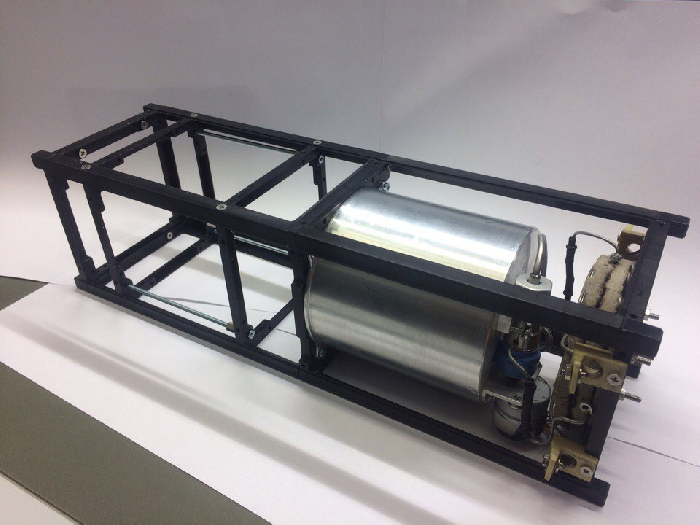Russian scientists have created an engine for cubes on 40% alcohol solution

SamSat-M satellite, three CubeSat units in size, i.e. 10 × 10 × 30 cm
Scientists of the Samara National Research University have developed a new shunting space engine for nanosatellites weighing less than 10 kg. The unique engine runs on a mixture of distilled water and ethyl alcohol (40% solution). Satellite tank is designed for approximately 450 grams of fuel.
Before entering the Laval nozzle, the mixture is evaporated using an electric heater, the resulting gas (steam) is heated to the required temperature with the same heater.
')
The engine is designed for the Russian SamSat-M nanosatellite. “We are currently testing a prototype, at the same time we are designing an experimental nanosatellite for carrying out flight design tests,” the university’s press service reported .
The SamSat-M nanosatellite with a propulsion system is designed for testing the maneuvering technology as part of a group of near-spacecraft.
In 2017, SamSat-M project documentation, design documentation, test programs and methods were developed. In 2018, it is planned to manufacture a nanosatellite and carry out the necessary work to prepare it for flight tests.
Nanosatellites with propulsion systems can maintain a given altitude in low orbits, where the influence of the atmosphere is great; can be used to reduce nanosatellites from orbit after the mission is completed; solve complex inspection tasks, including as part of cleaning up near-Earth space from space debris and saving astronauts during extra-ship-related activities, according to the website of the Center for Nanosatellite Technologies of the Samara National Research University. The grouping of nanosatellites can study geophysical fields, the thermosphere and the Earth’s ionosphere to predict natural disasters, identify asteroid hazards and inspect the state of spacecraft in space.
The press service emphasized the safety and environmental friendliness of the fuel for the engines: “A low molecular weight of water will provide high steam flow rates and, consequently, high maneuvering speed, and the addition of alcohol, about 40% of the mixture, will prevent the working fluid from freezing at low space temperatures ".

SamSat-M Satellite
The maximum mass of the fully charged innovative propulsion system is 1.55 kg. The expected total speed impulse is at least 80 m / s. The liquid working fluid of the propulsion system on a water-alcohol mixture with a total weight of 450 grams is stored in the tank. Since in flight, rapid heating of the working fluid is necessary, the developers proposed to supplement the satellite power system with drives on Maxwell supercapacitors. This will ensure the issuance of the necessary high pulse power to the heater. This approach will be applied for the first time on spacecraft of this class, the press service said.
If the Russian invention proves its efficiency, then such engines can be used for all CubeSat satellites, and recently this platform has become very popular for creating and launching mini-satellites. The Kubsat format made the distribution of university satellites wide, although large companies like Boeing also designed satellites of this format.
The base size of a kubsat (1U) is 10 × 10 × 10 × cm with a weight of not more than 1.33 kg. The standard allows the unification of two or three standard cubes in the composition of one satellite (indicated by 2U and 3U and have a size of 10 × 10 × 20 or 10 × 10 × 30 cm).
The cost of removing the Kubsat does not exceed several tens of thousands of dollars. Usually, several or several dozen of such satellites (up to seven dozen) are put into orbit by launch vehicles or from manned and automated cargo spacecraft and orbital stations. Also, ultra-small launch vehicles are being developed for the output of the Kubsat.
Theoretically, in such a format on ultra-small carriers, their satellites can launch into space also commercial companies, universities, schools and even private individuals.
Source: https://habr.com/ru/post/422595/
All Articles